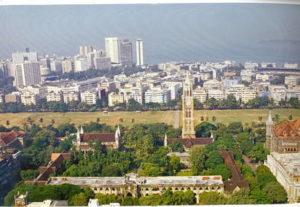
- Victorian Gothic and Art Deco buildings of Mumbai was declared as a World Heritage site by the United Nations Educational, Scientific and Cultural Organization, UNESCO on June 30, 2018.
- The decision was taken at the 42nd session of the World Heritage Committee of UNESCO in Bahrain. This makes Mumbai city the second city in India after Ahmedabad to be included on the World Heritage List.
Why Mumbai?
- As per the UNESCO, having become a global trading centre, the city of Mumbai implemented an ambitious urban planning project in the second half of the 19th century. It led to the construction of ensembles of public buildings bordering the Oval Maidan open space, first in the Victorian Neo-Gothic style and then, in the early 20th century, in the Art Deco idiom.
- The Victorian ensemble includes Indian elements suited to the climate, including balconies and verandas. The Art Deco edifices, with their cinemas and residential buildings, blend Indian design with Art Deco imagery, creating a unique style that has been described as Indo-Deco. These two ensembles bear testimony to the phases of modernization that Mumbai has undergone in the course of the 19th and 20th centuries.
- The Ensemble consists of 94 buildings primarily of 19th century Victorian Gothic revival and early 20thcentury Art Deco style of architecture with the Oval Maidan in the centre.
- The 19th century Victorian buildings form part of the larger Fort precinct situated to the east of the Oval Maidan. These public buildings include the Old Secretariat (1857-74), University Library and Convention Hall (1874-78), the Bombay High Court (1878), the Public Works Department Office (1872), Watson’s Hotel (1869), David Sasoon Library (1870), the Elphinstone College(1888), etc. The Art Deco styled buildings to the west of the Oval Maidan were raised in early 20th century on the newly reclaimed lands at Marine Drive and symbolised the shift in expression to represent contemporary aspirations.
New Inscribed Properties 2018
- Besides Mumbai, Aasivissuit – Nipisat (Inuit Hunting Ground between Ice and Sea) of Denmark, Al-Ahsa Oasis, an evolving Cultural Landscape (Saudi Arabia), Ancient City of Qalhat (Oman), Archaeological Border complex of Hedeby and the Danevirke of Germany, Hidden Christian Sites in the Nagasaki Region (Japan), Sansa, Buddhist Mountain Monasteries in Korea (Republic of Korea), Sassanid Archaeological Landscape of Fars Region of Iran , Thimlich Ohinga Archaeological Site (Kenya) were also included in the UNESCO World Heritage Site list on June 30, 2018.
UNESCO World Heritage Sites in India
- India now has overall 37 World Heritage Inscriptions with 29 Cultural, 07 Natural and 01 Mixed sites. In the past 5 years alone, India has managed to get inscribed seven of its properties/sites on the World Heritage List of UNESCO.
- While India stands second largest in number after China in terms of number of World Heritage properties in ASPAC (Asia and Pacific) region, it is overall sixth in the world.
- Following are the list of UNESCO World Heritage Sites in India:
- Agra Fort
- Ajanta Caves
- Ellora Caves
- Taj Mahal
- Group of Monuments at Mahabalipuram
- Sun Temple, Konârak
- Kaziranga National Park
- Keoladeo National Park
- Manas Wildlife Sanctuary
- Churches and Convents of Goa
- Fatehpur Sikri
- Group of Monuments at Hampi
- Khajuraho Group of Monuments
- Elephanta Caves
- Great Living Chola Temples
- Group of Monuments at Pattadakal
- Sundarbans National Park
- Nanda Devi and Valley of Flowers National Parks
- Buddhist Monuments at Sanchi
- Humayun’s Tomb, Delhi
- Qutb Minar and its Monuments, Delhi
- Mountain Railways of India
- Mahabodhi Temple Complex at Bodh Gaya
- Rock Shelters of Bhimbetka
- Champaner-Pavagadh Archaeological Park
- Chhatrapati Shivaji Terminus (formerly Victoria Terminus)
- Red Fort Complex
- The Jantar Mantar, Jaipur
- Western Ghats
- Hill Forts of Rajasthan
- Great Himalayan National Park Conservation Area
- Rani-ki-Vav (the Queen’s Stepwell) at Patan, Gujarat
- Archaeological Site of Nalanda Mahavihara (Nalanda University) at Nalanda, Bihar
- Khangchendzonga National Park
- The Architectural Work of Le Corbusier, an Outstanding Contribution to the Modern Movement *
- Historic City of Ahmadabad
- Victorian Gothic and Art Deco Ensembles of Mumbai


